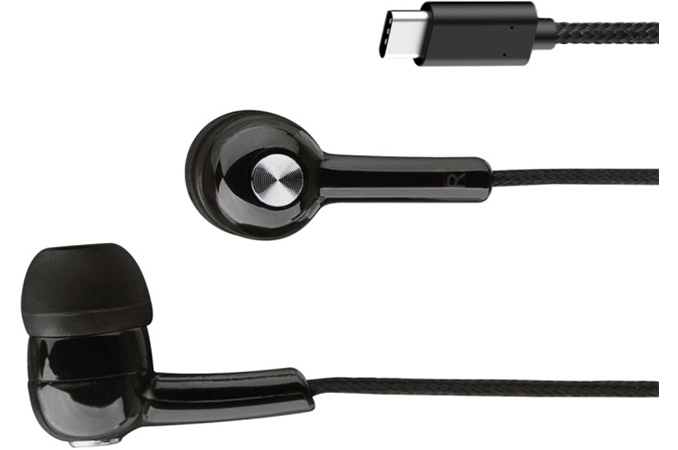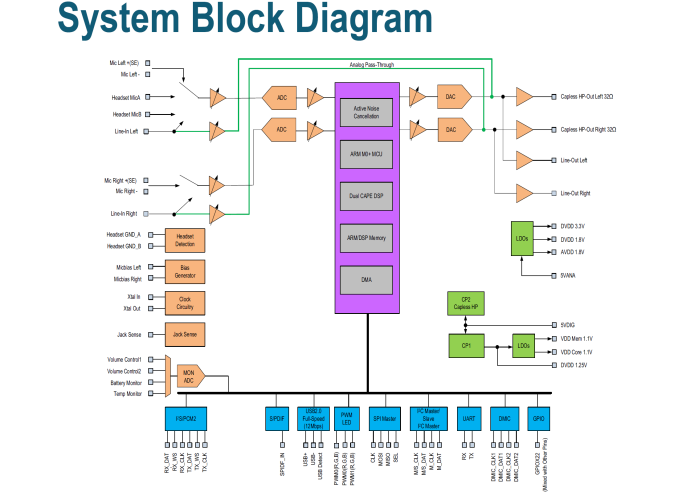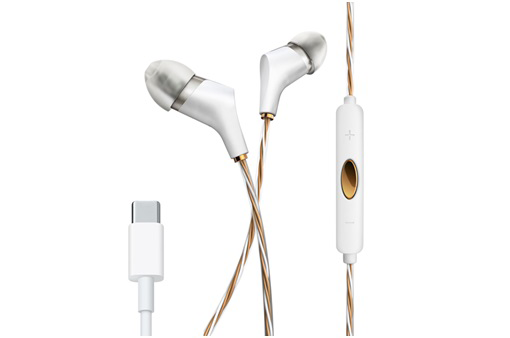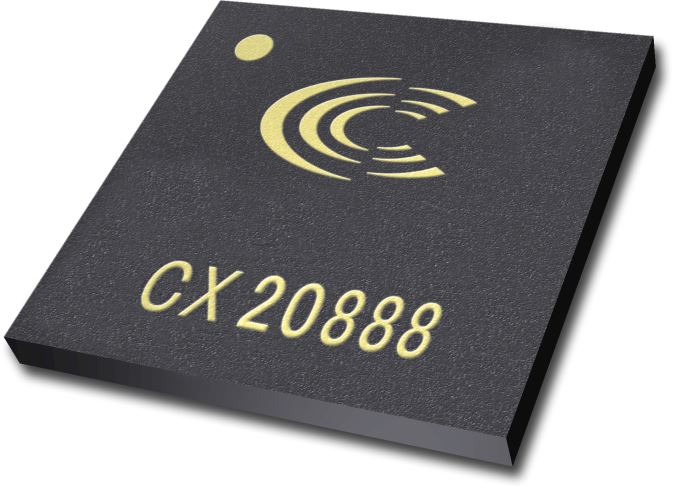Conexant Reveals CX20888: A New Chip for USB-C Headsets with Advanced Functionality
by Anton Shilov on June 29, 2016 1:40 PM EST- Posted in
- Mobile
- Intel
- Conexant
- USB-C
- USB-C Digital Audio

Conexant on Wednesday introduced its third CODEC for upcoming digital headsets using a USB Type-C interface. The new CX20888 chip is specifically tailored for headsets and supports a variety of advanced features, such as a headphone amplifier, active noise cancellation, sampling rates up to 96 kHz and so on. The company unveiled the product at the Mobile World Congress Shanghai in a bid to attract the attention of Chinese makers of consumer electronics.
The Conexant CX20888 is built around an ARM Cortex-M0 controller core (clocked at 50 MHz) and is equipped with two 32-bit Conexant DSPs (both clocked at 100 MHz) with floating point assist—bringing the total compute power of the DSPs to 400 MIPS—as well as 504 KB of SRAM that's shared between the M0 core and the DSPs. The CODEC also incorporates a variety of interfaces for peripherals, including two I2C master (or master + slave) interfaces, one I2S interface, one SPI, two multi-rate timers, a self wake-up timer, four monitor ADCs (to enable volume control, temperature sensor and battery monitor), two stereo PDM digital microphone interfaces, S/PDIF input and up to 28 GPIO pins.
Conexant utilizes the processing capabilities, as well as rich I/O features of the CX20888, to enable such functionality as low-latency active noise cancellation (eliminating up to 30 dB of external sound with a range of up to 3.8 kHz), acoustic echo canceling, equalization, microphone automatic gain control, volume control and others. The chip also supports a wake-on-voice trigger, which is important for enablement of services like Cortana that can listen to what is happening in its surroundings while the OS is in sleep mode.
To enable high-quality audio output, the CX20888 contains one 24-bit stereo ADC (97 dB dynamic range) and one 24-bit stereo DAC (104 dB dynamic range), supporting sampling rates between 8 kHz and 96 kHz. In addition, the chip incorporates a class-H headphone amplifier as well as programmable microphone preamplifiers with dedicated bias to prevent crosstalk. Because power circuitry is important for audio devices, the CX20888 has an integrated DC-DC converter with power switches and dynamic voltage scaling to ensure quality of output while keeping power consumption under control.
Like other USB-C Digital Audio solutions announced so far, the CX20888 supports USB 2.0 bandwidth, which should be plenty for audio and smart functionality. It also auto switches between CTIA and OMTP headsets if used inside a docking station.
Conexant tells us that the CX20888 is the industry’s only single-chip solution with such feature-set, which is suitable for digital USB-C headsets. The company naturally does not reveal the exact price of its solution, but claims that the chip reduces BOM costs of headsets because of its high level of integration. As for form factor, the CX20888 comes in 5×5×0.5 mm 81-pin BGA package and is small enough for a variety of designs.
Intel made a number of proposals for its part in the USB-C Digital Audio specification earlier this year and Conexant expects billions of people to adopt headsets and smartphones with a USB-C interface in the coming years (to support the transition of audio devices to USB-C, Conexant introduced two appropriate codecs earlier this year). The new interface is projected to improve the quality of headsets and expand their functionality by adding features, such as temperature sensors or noise cancellation technologies, but these depend entirely on decisions of actual hardware makers and not the standard itself. On paper USB-C Digital Audio enables a lot, but we will have to wait and see how it takes shape.
Source: Conexant



















55 Comments
View All Comments
Michael Bay - Sunday, July 3, 2016 - link
Oy vey, womyn got macroaggressed, such gevalt, it`s anudda shoah!Samus - Thursday, June 30, 2016 - link
I agree, there is no way your average sub-$100 digital USB headphones are going to have a DA converter, preamp and opamp superior to even the wolfson dac's found in iPods a decade ago.Ditching the 3.5mm jack is incredibly stupid. I used to think it was a good idea because of the added waterproof benefits of not having the gaping hole in the device, but Samsung and others have proven you can make an equipped device IP56 and even IP65 in the case of some Kyocera models. Apple is getting ridiculous here and unfortunately others are going to copy them.
grant3 - Wednesday, June 29, 2016 - link
Moving the DAC 2 feet further along a headset cable will do absolutely nothing to improve sound quality.The floor for noise/distortion in a headset will always be caused by the physical limitations of putting drivers in a container which fits in/around a human ear.
There is certainly merit in having amplifiers connect via USB. And maybe fancy headset functionality beyond the volume/pause controls in current headsets.
Impulses - Wednesday, June 29, 2016 - link
You're mixing apples and oranges, and having a DAC with a shitty opamp all housed in an already hard to design headphone shell will accomplish exactly nothing of what you're describing.There ARE some benefits, but for the most part they have nothing to do with this...
8steve8 - Thursday, June 30, 2016 - link
I'm not commenting on this specific DA - amp design, but in general, putting the D/A and amps closer to the speakers is better... and when the designer of the amp knows EXACTLY what speakers are attached. that is a huge advantage and they could achieve a better outcome than someone who has to use a general purpose amp to power a variety of speakers.Impulses - Friday, July 1, 2016 - link
The meager shortening of signal path accomplishes absolutely nothing in that real world... Matching amps and drivers could have more potential but that's not gonna happen when OEM buy commoditized chips like these, and headphone makers driving out of their lane into custom ICs seems even less likely.Increased use of DSP is the most likely scenario, and we really didn't need Type C for that...
Defhammer - Wednesday, June 29, 2016 - link
One of the biggest fears of using the Type-C port for earbuds is the stresses exerted on the plug and the phone connector when you put the phone into your pocket.One of the nice things a 3.5mm jack with a right angle plug could do is rotate and have a lower profile to minimize the mechanical stresses.
With the Type-C earbuds, imagine sticking your phone in your pocket with Type-C plug pointing towards the bottom of your pocket. The wire would be pinched almost 180 degrees at the base of the plug. This creates a point of failure for the earbuds.
On top of that, because the Type-C plug has a higher profile than right angle 3.5mm plug, it will be easier to put higher bending forces that could shorten the life of the earbuds and the connector on your phone.
At least if the 3.5mm jack broke, you still had the rest of your phone. With this, imagine breaking your USB connector so you can’t charge it.
I will give one counterpoint. when you put your phone in your pocket, you normally put it in upside-down with the connector pointing towards the opening negating most of these stresses.
In the end, make sure you have a clear understanding on how you are going to use your phone and earbuds and weigh the advantages and the disadvantages.
TL;DR version: It will be easier to break your Type-C earbuds and the connector on your phone if you put your phone in your pocket connector down with the earbuds plugged in.
Shadowmaster625 - Wednesday, June 29, 2016 - link
But who would pass up the chance to sell something that has a higher failure rate? Then they get to sell more of em! Yay!BedfordTim - Wednesday, June 29, 2016 - link
Your point is still valid but most phones with a type C connector also have QI charging so your phone will still work. To my mind wireless headphones make much more sense than Type-C.Impulses - Wednesday, June 29, 2016 - link
I dunno, I love Qi but so far adoption rate for wireless charging isn't very high.